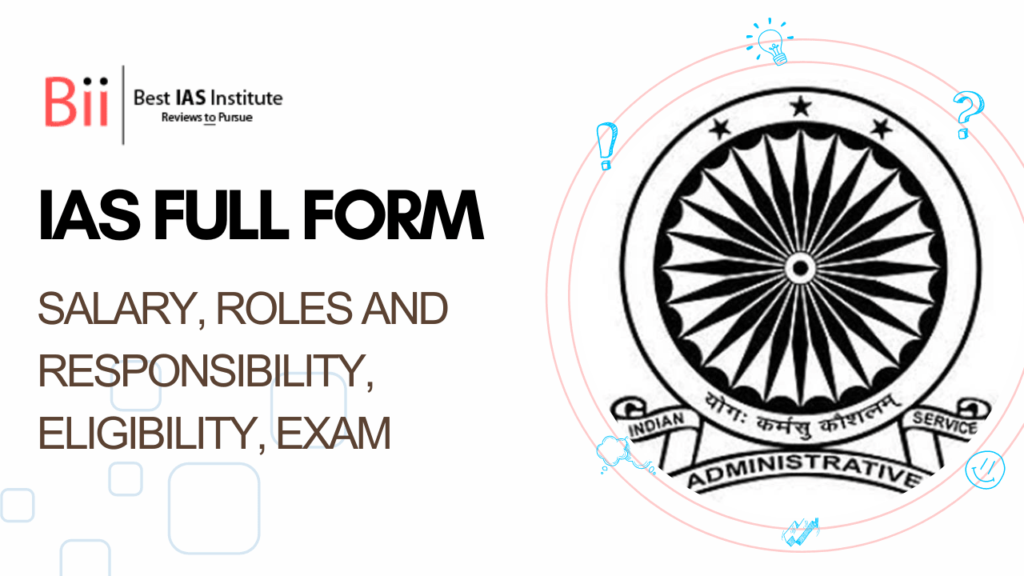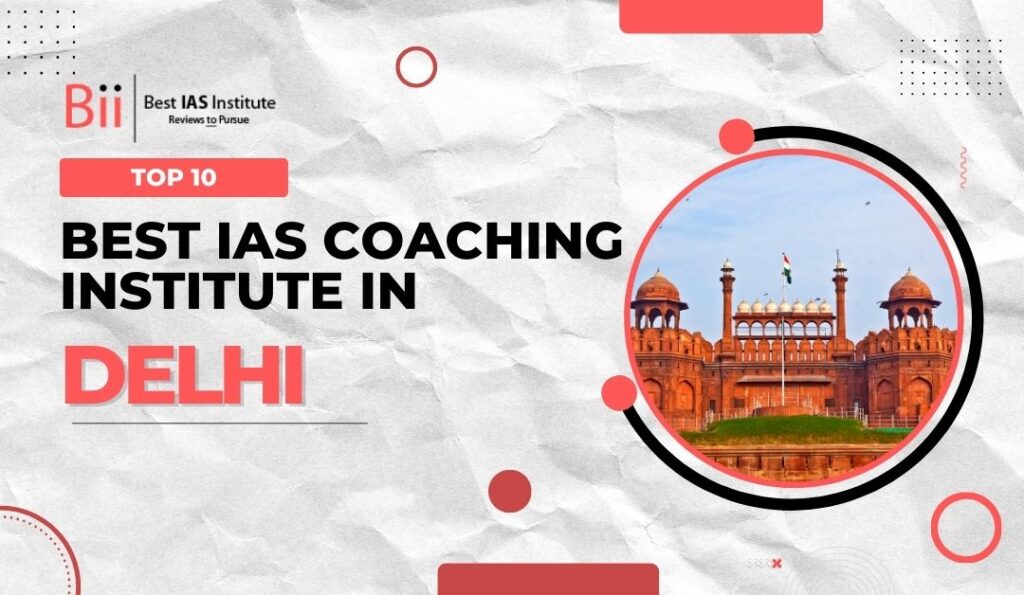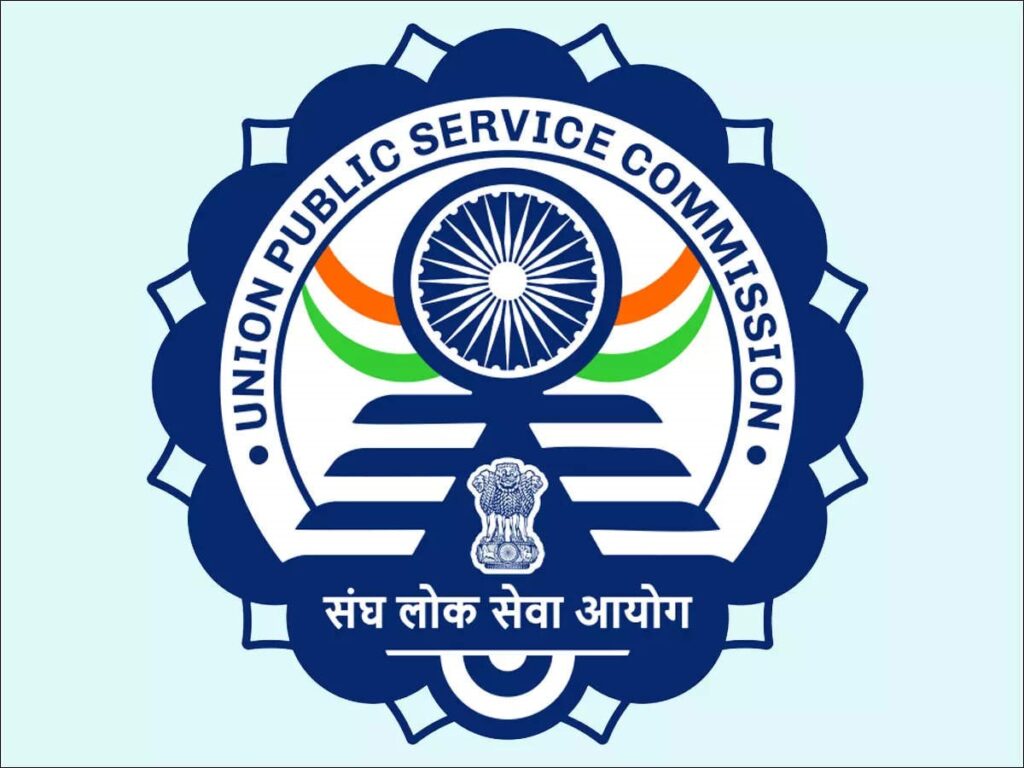
What is IAS Full Form?
The IAS full form represents Indian Administrative Service. One must pass the UPSC Civil Services Exam (CSE) Exam in order to be appointed as an IAS officer. An IAS official is tasked with managing various governmental affairs at all levels of government, from the district Level.
| IAS Full Form | |
| IAS Full Form in English | Indian Administrative Service |
| IAS Full Form in Hindi | भारतीय प्रशासनिक सेवा |
| Role of IAS | Keeping peace and order, managing government activities, maintaining total expenditures, etc |
What is IAS?
IAS is one of the three All-India Services of the country conducted under UPSC, along with IPS and IFS. IAS Full Form is the Indian Administrative Service. Founded in 1858,The Indian Administrative Service exam was the Imperial Civil Service. In the year 1950, it was established as the Indian Administrative Service or the IAS. Among all the other Indian administrative posts, the IAS assumes the highest rank both in terms of power and prestige.
Eligibility Criteria for IAS Exam
IAS stands for Indian Administrative service. To become an IAS one can qualify the Entrance exam conducted by UPSC.
UPSC Examination is one of the toughest exams to be conducted in India. UPSC stands for Union Public Service Commission is the government agency responsible for the recruitment of officers into the civil services commission and make their career as IAS,IFS,IPS etc. officers. The UPSC exam is conducted and candidates are selected on the basis of eligibility ,age ,education qualification criteria. The civil services includes
- Indian Administrative Service (IAS)
- Indian Foreign Service (IFS)
- Indian Police Service (IPS)
- Indian Revenue Service (IRS)
The civil services are the backbone of the administration of the country. Let’s also have a look at the eligibility criteria required to be satisfied in order to appear for UPSC IAS Examination. Aspirants are needed to satisfy the following conditions to become eligible for the exam:
- Candidate must be a citizen of India, or a citizen of Nepal, Bhutan or Tibet who resided in India before 1st January, 1962.
- Candidates must have graduated from a recognized college or university or any equivalent qualification.
- The minimum age at which a candidate can appear for the exam is 21.
- Number Of Attempts and age limit based on category: –
| Category | Age | No. of Attempts |
| General Category | 6 Attempts | 32 Years |
| SC/ST Category | Unlimited Attempts | 37 Years |
| OBC Category | 9 Attempts | 35 Years |
| Economically Weaker Section (EWS) | 9 Attempts, | 32 Years |
| Ex-Servicemen Commission Officer | 9 Attempts | 32 years old (If General category)35 Years (If OBC Category)38 Years (If SC/ST category) |
| Disabled and discharged defence service personnel | 9 Attempts | 35 Years old |
IAS Exam Pattern
The exam pattern is designed in well structured form from past years. The UPSC CSE is held in three stages namely Preliminary, Mains, and Personal Interview discussed in brief below;
Stage 1: – Preliminary Exam
The first stage is – Preliminary Stage ,to become an IAS Officer this stage plays an important role as it is only required to qualify the required cutoff to pass this stage.It comprises two papers of 200 marks each containing objective type questions. The duration to attempt each exam is 2 hours which needs to be mandatorily attempted by the candidates. The candidates need to score qualifying marks to clear the cut-off. The duration of the exam is two hours. Paper-2 (CSAT) in the Civil Services (Preliminary) Examination is a qualifying paper with minimum qualifying marks fixed at 33% may change by time. The Preliminary stage consists of two papers of 200 marks each. The question papers will be set in both Hindi and English.
Stage 2: – Mains Exam
The Mains exam- this stage is all matter,and only mains score counted in cutoff .Candidates who qualify the Preliminary exam are required to be eligible for the Main exam. The UPSC mains exam is conducted in 2 steps: – qualifying papers and merit exams. There are a total of 9 papers in the Mains exam. Every paper is of 3 hours and an extra 30 minutes extra is given to physically disabled students.
The mains examination ,Paper A and Paper B are 300 marks each and the remaining papers are 250 marks each.
Stage 3: – Personality Test/ Interview
The Personality Test/Interview- After qualifying the IAS Mains paper ,they called for an interview as this is the last stage of becoming an IAS Officer.On the basis of marks secured in the Main exam, the candidates will be called for Interview. The personality test is conducted for 275 marks.
Roles and Responsibility of IAS Officer
IAS officers are responsible for supervising the implementation of government schemes and policies. IAS officers are also responsible for responding to natural calamities and riots.the list of roles is given below;
- They are responsible for supervising the administrative activities within the division assigned to them in particular cadre.
- IAS officers are responsible for the maintenance of law and order by coordinating and providing necessary support to restore law and order and help individuals affected by natural calamities or riots.
- To manage the staff working under them. They are responsible for making reports based on the evaluation of their services.
- They advise and help elected representatives formulate and draft policies for making the right decisions.
Some other roles and responsibilities of IAS officers that they are supposed to perform are mentioned below:
- Roles under Sub-Divisional Functions: IAS officers are responsible for maintaining law and order and look after the developmental and administrative activities as a Sub- divisional functions.
- Roles under District-Level Functions: IAS officers are responsible to perform the similar functions of an SDM as a District- level Functions.
- Roles under Public Sector Undertakings: Many IAS officers get posted to PSU cadres on the committee as a PSU.
IAS Officer Salary Per Month
Initially appointed IAS officers get a monthly salary of 56,100/- per month without factoring in additional allowances like TA, DA, and HRA. The highest-earning IAS officer, the Cabinet Secretary, can receive a monthly income of up to 2,50,000/-
| IAS Salary | Salary of An IAS Officer Details (INR) |
| IAS Officer Per Month Salary | 56100 |
| Salary of IAS Officer During Training | Approx. 33,000–35,000 |
| IAS Salary after 8 Years of Service | 1,31,249 per month or 15.75 lakh per year |
| Maximum Salary of IAS Officer | 2,50,000 |
IAS Officer Monthly Salary in India- 7th Pay Commission
As per the latest 7th Pay commission, the IAS Officer Salary per Month in the Starting and at the entry level is ₹56100, which leads to ₹56100 – 132000 per month. After years of service and each promotion, the IAS salary in India per month increases with duration. Check the table below to get more clear about IAS Salary;
| IAS Rank Wise Post | IAS Basic Pay | IAS Pay Level | Total Years of Service |
| SDM, Undersecretary, Assistant Secretary | ₹56100 | 10 | 1-4 years |
| ADM, Deputy Secretary, Undersecretary | ₹67,700 | 11 | 5-8 years |
| District Magistrate, Joint Secretary, Deputy Secretary | ₹78,800 | 12 | 9-12 years |
| District Magistrate, Deputy Secretary, Director | ₹1,18,500 | 13 | 13-16 years |
| Divisional Commissioner, Secretary-cum-Commissioner, Joint Secretary | ₹1,44,200 | 14 | 16-24 years |
| Divisional Commissioner, Principal Secretary, Additional Secretary | ₹1,82,200 | 15 | 25-30 years |
| Additional Chief Secretary | ₹2,05,400 | 16 | 30-33 years |
| Chief Secretary and Secretary | ₹2,25,000 | 17 | 34-36 years |
| Cabinet Secretary of India | ₹2,50,000 | 18 | 37+ years |
Conclusion
IAS is Indian Administrative Service ,The exam is conducted by UPSC (Union Public Service Commission) .The journey to becoming an IAS officer is challenging but rewarding and fruitful. With the right strategy, guidance, and hard work, you can achieve your dream of serving the nation as an IAS officer. The IAS is a part of the executive branch of the Government of India and is regarded as the permanent bureaucracy. Lakhs of aspiring candidates belonging to different categories of society, attempt the exam each year.
Also Read: IPS Full Form



